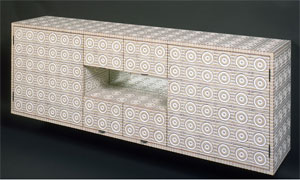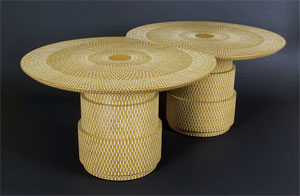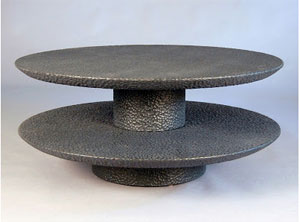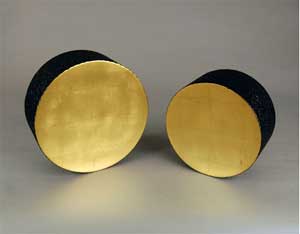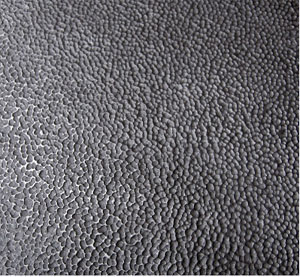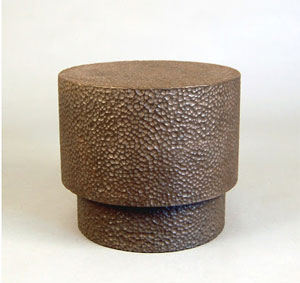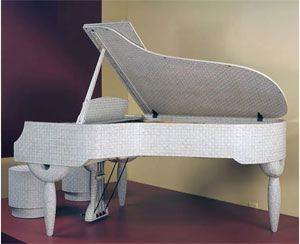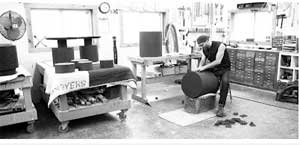
By the time John Eric Byers graduated from college, he realized he didn’t want to be the teacher he’d studied to become. Instead, he preferred to work with his hands. Having earned money throughout college and high school summers with work in others’ woodworking shops, John Eric found woodworking to be an appealing road to achieve that goal.
John Eric had grown up in Rochester,New York, and, at the time he graduated from college, famed woodworker Wendell Castle, a founder of the art furniture movement, had a school there. John trained at that school for two years in the mid 1980s. “When I was there, there were 30 students: 15 first-year and 15 second-year, and Wendell’s studio was in the downstairs section.”
After finishing that training — which included design courses from Wendell Castle and technical classes from other faculty — “at first, I was just going to look for a job,” John Eric said. “Wendell’s advice was to do my stuff full-time and other people’s stuff part-time.” He ended up accepting a position as an artist-in-residence in Philadelphia — with a New York Foundation of the Arts grant he’d received for his student work financing the move — and, after a couple of years there, took a job making furniture for a designer with a showroom in Manhattan.
“At school, I’d learned about being meticulous and using hand tools,” John Eric said. While working with Bob Ingram, “I learned how to make a living, how to be efficient in the machine shop.” Throughout all that time, “Within the mix, I was making my own speculative, one-of-a-kind pieces,” John Eric said. “Studio furniture was big then.”
“When I first started making work at school, I just wanted to be a woodworker,” Eric said. “I was excited just about anything related to wood.” As he began to explore more of what he wanted his style to be, he noticed a couple of guys at school who were painting their pieces, covering up the wood and focusing on form. John Eric began emphasizing form and monochromatic finish on his pieces while in school and now, 25 years later, he said, “My work has never been about the beauty of the material. It’s about the beauty of working with the material.
“I paint pieces black because there’s no way you can disguise the scaling, proportion and form,” John Eric said. “My canvas is the work I do with finishing.” Although he’s gained in sophistication with 25 years of experience in finishing, “I’ve always held on to milk paint, or an opaque finish,” he said. “I’ve always responded to textiles, and ceramics has always been a big love of mine, and milk paint has a glaze quality to it.
“I’m drawn to the tactile experience, where you go up to a beautifully sanded piece of wood and run your hand over it, and it feels so good. I’m trying to create that tactile experience with my own work, to create my own surface.” From a distance, he said, you might see that a piece of his has good presence, proportion and scale, “but as you get closer to the design, closer to the work, you see the individual characteristics of the surface.”
Although structurally, his pieces might look as if they’re made with solid wood, they are actually a version of hollow core stack laminate, John Eric said. The pieces are lighter than they appear, and very sturdy. For several years, John Eric used a lot of mahogany and sapele, but he has had to decrease his use of those woods after developing allergies. Currently, he’s using mostly domestic hardwoods such as ash, poplar and cherry for their working qualities, describing cherry as “a wonderful surface to work with for carving tools” and poplar as “OK, but not as consistent.”
In all of his work from 2000 to 2008, he did all of his surfacing via hand carving. Following three shoulder surgeries in six years due to overuse from repetitive carving on surfaces, however, he’s now using a mix of hand gouges and power carving tools to create his textured surfaces.
“The most intensive piece I ever built was the piano I did for Steinway and Sons,” John Eric said. “The amount of labor I put into that piece was the equivalent of six months for seven days a week. It took about a year for two of my fingers to work right because of all the carving I did on the piece.”
Although it was interesting to collaborate with a company for that piece, John Eric said, “It’s always the next piece you get really excited about. That’s what motivates you; you just want to keep creating stuff.”
